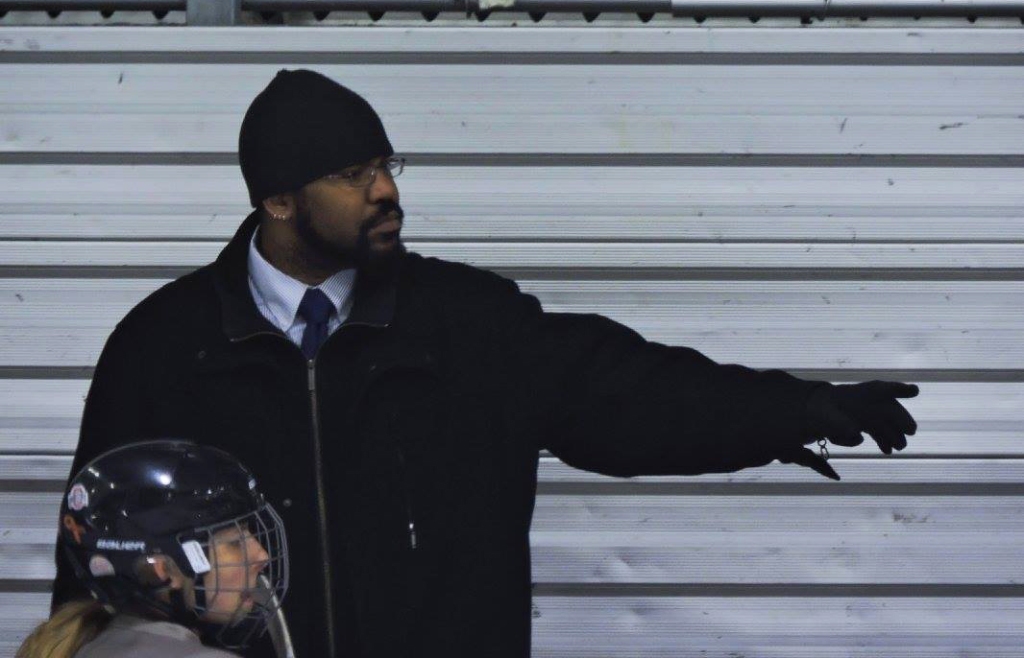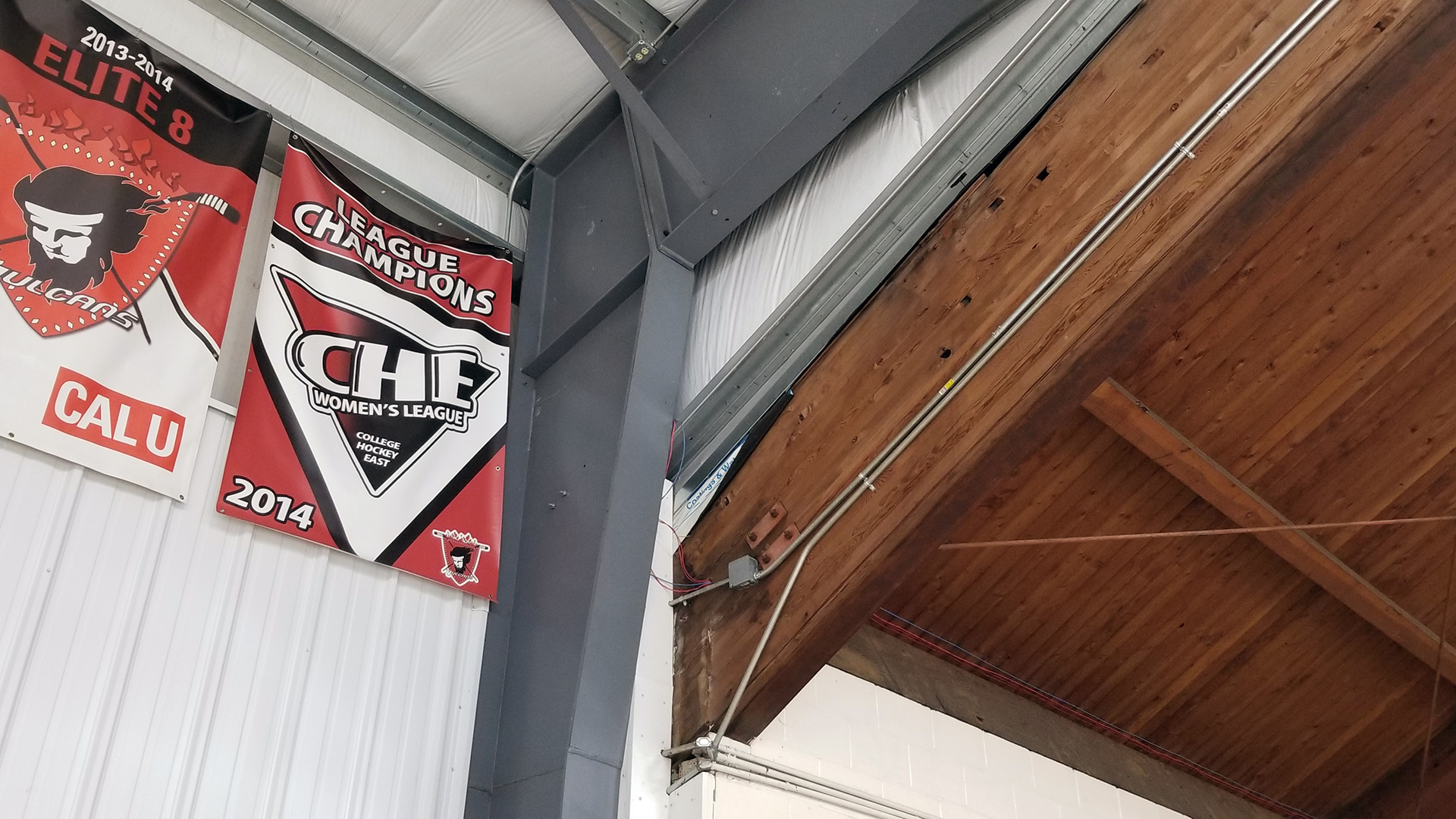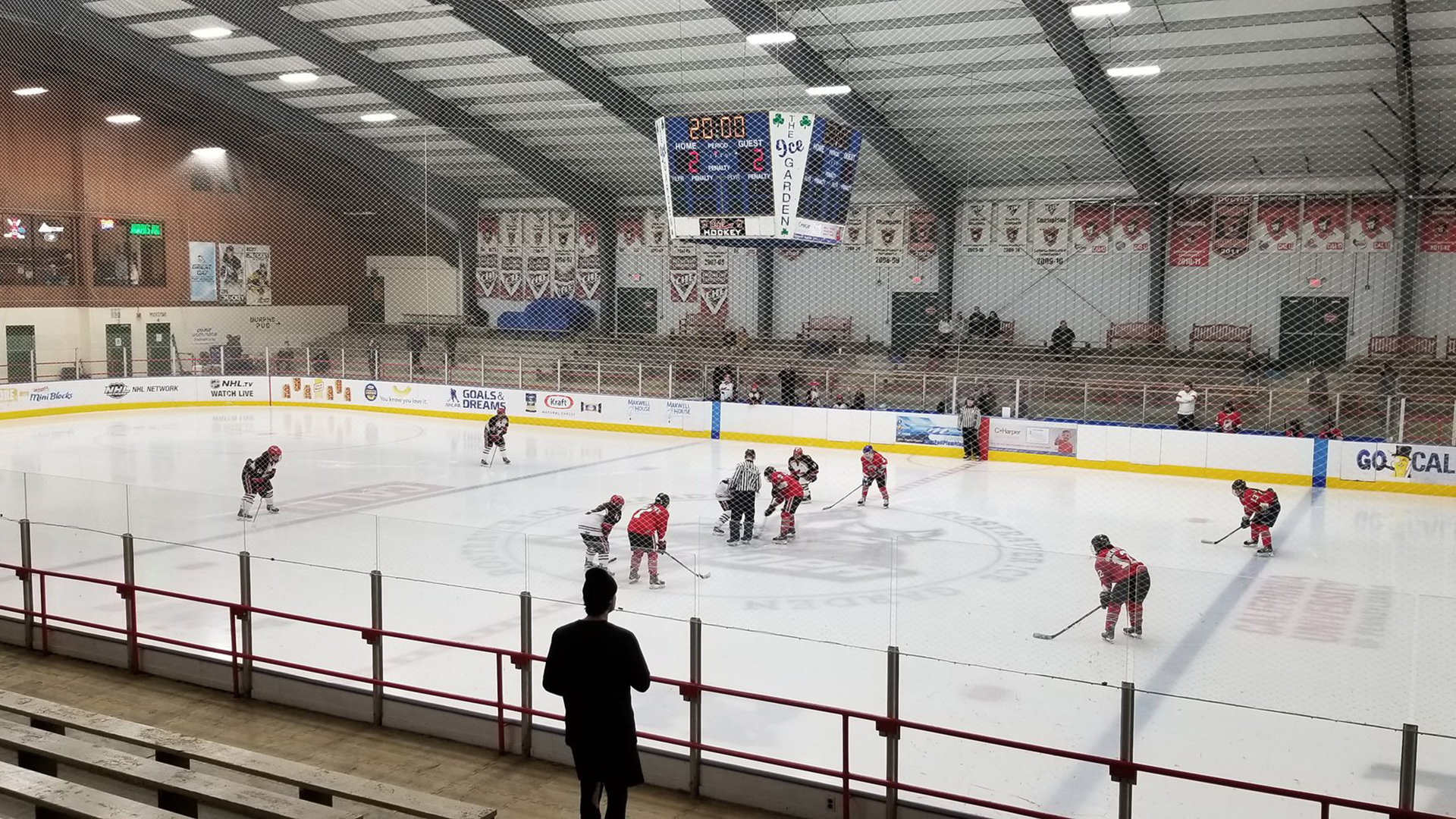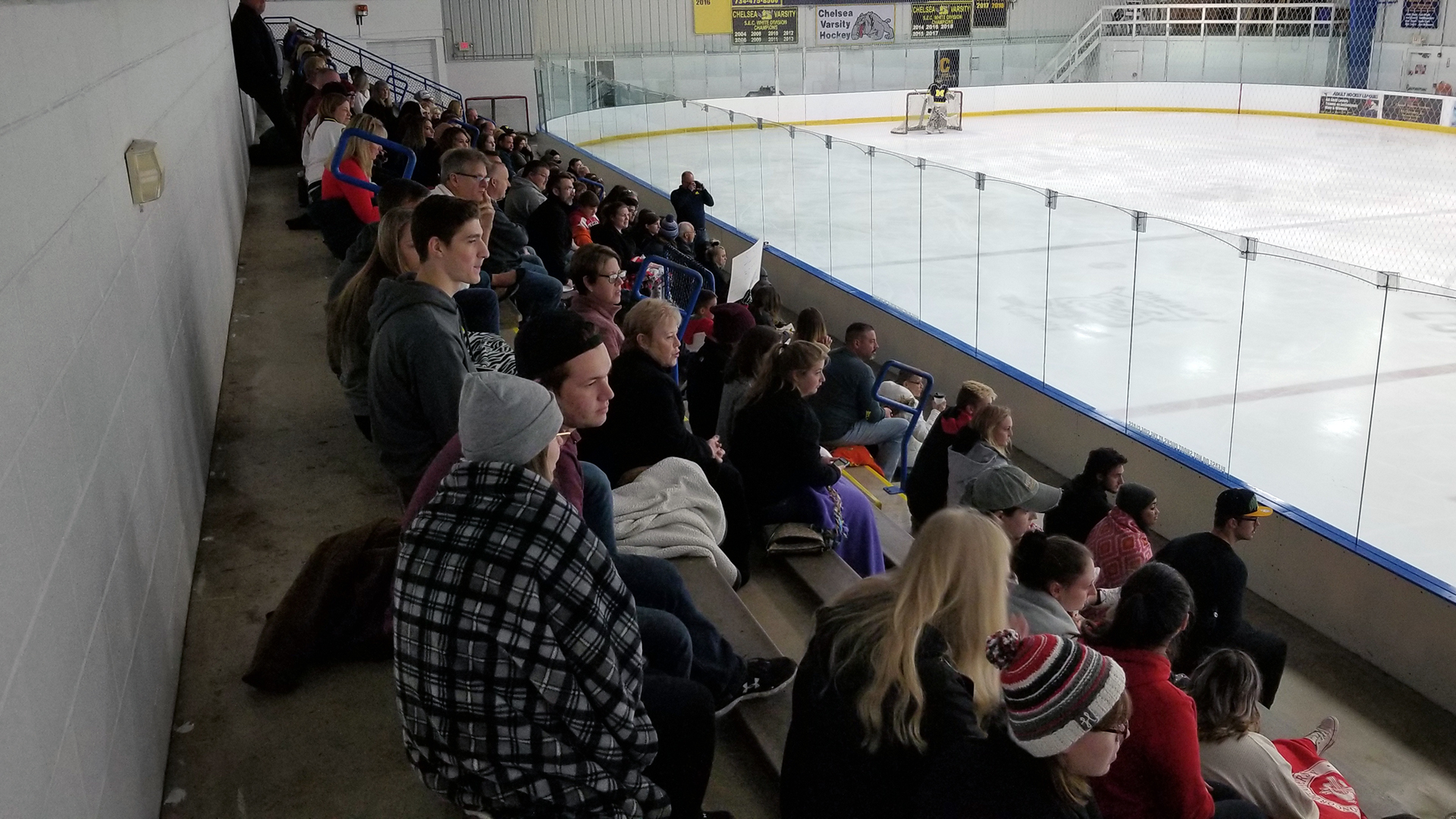June 14, 2020

As she skated to the blue line at The Ohio State University Ice Rink for the pregame ceremonials prior to the Buckeyes’ 2017-18 opener against Michigan, Nora Anderson was a bit nervous.
It’s natural, of course, for anyone in Anderson’s skates to feel some anxiety. She was about to do something she had done on numerous occasions previously, however this time was different. Not only was it the season-launching contest against the hated team up north, it was her debut in scarlet and grey. And while nobody will confuse a typical ACHA women’s game atmosphere for Saturday night at Madison Square Garden, Anderson was nevertheless the center of attention on a bigger stage than she had known to that point.
But, when things came down to it, her best instincts kicked in. The familiar opening bars of “The Star-Spangled Banner” played, Anderson dropped to one knee, and she was joined by teammates Kaitlin Berigan, Julia Phillips, and Mikayla Richter.
You undoubtedly know Colin Kaepernick. While the former San Francisco 49ers quarterback didn’t invent the concept of national anthem protests, he became the modern face of them in 2016 when he began taking a knee to draw attention to police brutality and other issues facing people of color. Kaepernick was eventually joined by roughly 200 other NFL players at one point, before the league effected a policy against the practice prior to the 2018 season (and probably blackballed Kaepernick as well).
It’s likely that you also know Megan Rapinoe. The U.S. national soccer team star backed Kaepernick’s efforts by kneeling prior to a match against Thailand in 2016 (and once before that with the Seattle Reign, her professional team), but was similarly cut off from future protests by a hastily-enacted U.S. Soccer Federation rule.
If you’re a hockey person, you’re probably familiar with John Tortorella and J.T. Brown as well. The fiery Tortorella, the Columbus Blue Jackets’ head coach, was asked about the Kaepernick protests in 2016 while coaching Team USA at the World Cup of Hockey and infamously said “If any of my players sit on the bench for the national anthem, they will sit there the rest of the game.” The hockey community, noted for its – let’s just come out and say it – whiteness, conservatism, and commitments to authority and the group ahead of any spirit of individualism, overwhelmingly supported Tortorella.
Brown, then playing with the Tampa Bay Lightning, was an exception, quickly tweeting “Wouldn’t benching a black man for taking a stance only further prove Kap’s point of oppression?” in response. He later backed up his words with action by raising his fist during the anthem on October 7, 2017 in support of Kaepernick and his cause.
“I remember that, and Seth Jones said he found kneeling disrespectful too,” Berigan said. “I thought it was a peaceful way to protest, and mostly I just saw how negatively it was taken. I was an intern with the Blue Jackets at the time, and one of my main jobs was to send out Leo [Welsh, the Jackets’ anthem singer] and the military honor guard every game. So I really felt like that wasn’t a safe place for me to voice my opinion.”
“It just always felt, especially in hockey, that kind of stuff just doesn’t fly.”
Nevertheless, just four miles north of Tortorella’s home ice in Nationwide Arena, seven days prior to Brown’s protest, and with much more anonymity than either man ever receives, Berigan, Anderson, and a couple of their teammates first made their own stand, by refusing to do so.
There are a few things you should understand about Anderson. She’s outspoken and passionate, that much may already be obvious, but her opinions are educated – she played hockey as a law student and is now an immigration attorney in Cincinnati – carefully considered, and deeply researched in a way that flies against the “outspoken and passionate” stereotype. And kneeling for the national anthem wasn’t something that came to her on a whim or because Kaepernick made it trendy.
“I haven’t stood for the national anthem in years,” she said. “I didn’t decide to do it in 2017 just out of the blue, it came to me slowly.”

Her upbringing was typically American in that she was raised in a culture of national reverence, enhanced by a dozen years in the Girl Scouts and its quasi-militaristic program of flag ceremonies and patriotic songs.
“I think that’s good actually, that you as a young person should learn the traditions of your country,” Anderson said. “But one of the things that really was an issue for me in the back of my mind was that growing up in Columbus, Columbus police are one of the most violent police forces in the country, and I think that’s very much still true to this day.”
A transformative experience came from a church-sponsored year of service she completed between her undergraduate degree and law school. Anderson lived as an economically disadvantaged person during that time, an attempt to truly understand the less fortunate.
“Experiencing the other end of life in Columbus, living in a low-income neighborhood, was really eye opening,” she said. “It was also at that point in time that the Ferguson protests were taking place. The combination of those two things were…what is it about this country that makes it worth respecting, that makes it worth standing for the national anthem? At that point, if I went to a major sporting event like an Ohio State football game, I would just sit down, I just wouldn’t do anything.”
“I still don’t stand for the national anthem, because people are still being murdered by the state.”
Anderson has a highly unconventional hockey background. She didn’t learn to skate until she was 22, and mostly learned the game playing roller hockey at Tuttle Park, as she put it, “just getting absolutely hustled, getting my ass kicked by all the roller hockey guys there.” Through that experience and sessions through the Chiller rinks, she eventually got to the point where she felt she could hang with the club team at Ohio State, fulfilling a dream of competing for the Buckeyes.
There was just one issue: her refusal to stand for the national anthem. Figuring she had nothing to lose, Anderson approached head coach Derrick Henderson, then the whole team, and found a receptive audience.
“My reaction was just shock,” Henderson said. “I didn’t think it was going to be a thing. Inevitably, you always think about what you’d do in that situation. I know what I would have done, or I’d like to think I know what I would have done, but as a coach, I can’t really do anything.”
“So when Nora comes up and she says she wants to do this, she says ‘I heard we play the anthem before games…yeah, I’m not doing that.’ And I was like wait, what? We’re all a team, I’ve got your back, that’s not a problem, but make sure it’s cool with your team. You guys have to have this discussion, because I don’t want to just drop things on them. Because if they don’t support it, then I can’t really support it, but we’ll figure out something to make it work for you.”
Henderson probably didn’t need to be worried. Ten minutes later, Richter and Phillips came up from OSU’s infamous basement locker rooms and said that they were in as well. Berigan missed that initial meeting due to her internship but caught wind of the idea later, and surprised Henderson by spontaneously joining the protest. While participation never exceeded four (of 14 players on the Buckeyes’ roster), nobody expressed any objections.
“The anthem didn’t really represent anything I believed either, so I thought it was really cool to have other girls on the team who had a similar way of thinking as I did,” Berigan said. “I had friends growing up that were Black, that played on my team, so I’d been discussing things with people since then. It seemed like the right thing to do, it didn’t really feel like a decision.”
The fact that her coach, Henderson, was Black wasn’t lost on her either.
“I think he really was kind of touched by that,” she said. “I don’t want to come across with the white savior mentality, but I didn’t realize how much until he started tweeting about it again recently. He still thinks about that, so I guess that made it worth it.”

From those initial steps, Henderson developed a plan to make sure everyone was protected and to reduce any possible friction. He cleared the idea with the university and its rec sports department, the CCWHA, and the ACHA, and those organizations were supportive. Home games, he reasoned, were in their house, so their wishes would apply. But for road games, he checked ahead with the hosts to make sure kneeling would be okay. Two teams, Mercyhurst and Miami, took issue, so Anderson and the others remained in the locker room during the anthem before those contests.
All in all, there were very few hiccups. Sure, there was plenty of awkwardness, a few people sharing photos with non-committal “I’m not taking sides here, just reporting the facts” comments, but many were also supportive. Michigan’s Caroline Hurd even joined in the kneeling during the season’s opening weekend.
“I honestly have so much respect for her, because I don’t know if I would’ve done it if it was just me,” Berigan said.
“After hearing all of the hype with Kaepernick and the NFL, and all of the backlash he got, it was a really interesting moment for me to experience it firsthand right before playing a hockey game,” Rachel Arias, who skated against the Buckeyes with Robert Morris, said. “It was definitely a moment where I felt like the girls were doing it out of respect for what they believe in.”
Then there was Adrian.
“Adrian was hysterical to me,” Henderson said. “At first when it happened, it was kind of like shock, people were like ‘oh my gosh.’ But we got through day one.”
“Day two we did it, and some girls in the crowd decided that they were going to quote-unquote taunt us by singing the national anthem, because they just used the canned music you get from YouTube.”
“And you know what happens when you’re singing a song and you get to a part and you realize you don’t know the words to this part, you just kind of mumble your way through it, power through to the part that you do know? You could kind of see that they got to a part where they didn’t really know the words. So it starts with them just belting out the national anthem, and then dying out and stopping because they forgot the words. That is priceless to me.”
By the time OSU traveled to take on the Bulldogs, the counter-narrative of “kneeling is disrespectful to the military” had fully taken hold. And Adrian might have been the most military-friendly team in the ACHA, outside of the service academies, thanks largely to a fundraiser that involved the team donating to Wounded Warrior Project for each goal scored.
There were a few taunts from fans following the anthem, then things spilled over to Twitter after the game. The Bulldogs’ Sam Fortune, who spearheaded the WWP fundraiser, was respectful and simply restated her beliefs: “I love my country. I respect our troops. And I will always stand for the national anthem! #FreedomAintFree,” followed by “Meanwhile we’re raising money for our veterans with our annual ‘goal-a-thon’ if you’d like to pledge plz visit our website! #WachaStands.” Others got a bit nastier.
“They were the only school, the only series of games, where somebody made a stink about it,” Henderson said. “We knew it wasn’t anything to do with the flag and the military because we’re smart people and can understand nuance.”
“People would come up to me and say ‘oh I have grandparents and family who served in the military, and that’s what the flag means to me.’ And I’d have to sit there and say, I’m Black. My grandfathers fought in the war. And you know what? When they came home from serving their country with honor and distinction, they had to come home to that same country not giving them personal freedoms. Not giving them the G.I. Bill loan with money they were promised they could get. Segregated housing, because the guy who created the town I was born in and lived in didn’t want Black people living in his town, despite the fact that it was supposed to be for military housing.”
“One of the things that really bothered me is that people would say ‘you’re disrespecting the flag, you’re disrespecting America,’” Anderson added. “In no way am I doing that. I think America was founded on the promise – the partial promise, I should say – that each person has the right to choose their own destiny and their own freedom.”
“If we had an America that lived up to that promise, one in which our Black citizens could literally have life, liberty, and the pursuit of their own happiness, I think we would be in a much better place. Why can’t we live up to that promise? It’s a false narrative that it’s somehow disrespecting the troops. That’s not the case at all.”
Nonviolent direct action seeks to create such a crisis and foster such a tension that a community which has constantly refused to negotiate is forced to confront the issue. It seeks so to dramatize the issue that it can no longer be ignored. My citing the creation of tension as part of the work of the nonviolent resister may sound rather shocking. But I must confess that I am not afraid of the word “tension.” I have earnestly opposed violent tension, but there is a type of constructive, nonviolent tension which is necessary for growth.
Martin Luther King, Jr., Letter from a Birmingham Jail
Whatever your beliefs, there’s something a bit jarring about an anthem protest. Something that violates comfort zones, following a lifetime of culturally-conditioned obedience to the phrase “ladies and gentlemen, please rise and remove your hats.” Even after seeing clips of various athletes kneeling hundreds of times over the previous year, witnessing the Buckeyes do it in person still made me say “whoa, this is big.” And that’s precisely the point.
“It’s intended to be a conversation starter, but not a conversation finisher,” Anderson explained. “Not standing for the national anthem is not the end-all be-all. If that’s the only thing you’re doing, then I don’t know why you’re here. If that is the end-all be-all of your activism, then you’re a weak activist.”
Really though, the activists were never the flaw.
Kaepernick tried to tell us, with his protests coming largely in reaction to the murders of Trayvon Martin, Michael Brown, and Eric Garner (the latter two coming at the hands of the police, and among many others) in 2013 and 2014. So did Rapinoe, Brown, and the quartet of Buckeyes in following Kaepernick’s lead. Former NHL player Akim Aliu detailed his experiences with racism through a heart-rending piece in The Players’ Tribune just last month.

For his part, Henderson tried to open the lines of communication several times during OSU’s version of the protests, but nobody took him up on the offer: “Nobody had the curiosity, they wanted their opinion, and then they left it at that.”
So we failed to receive each message, and the issue festered until a new round of police murders – most famously including George Floyd – lit up major cities across the world in protest, beginning in late May.
The recent events, necessarily more widespread, forceful, and jarring than ever before, have cast the kneelers in a new light and have forced a reckoning across the sports world as well. Kaepernick has largely been vindicated, a grassroots push to get him back in the NFL is underway, and it’s expected that numerous other players will begin kneeling when the season gets started. The U.S. Soccer Federation reversed their rule. Even Tortorella has come around a bit, recently telling The Athletic that he has “learned over the years, listening and watching, that men and women who choose to kneel during this time mean no disrespect toward the flag.”
“It’s not like there’s a hipster culture of ‘oh I was protesting before it was cool,’ that’s not at all how I feel,” Anderson said. If you come to the realization that something needs to change in this nation, I don’t care when you come to that conclusion, I just care that you’ve come there.”
“From the history of protests over Black people or other people of color being murdered by police, it’s been a very one-sided discussion. And I say that in a way that, one of the things that was very present in the Ferguson era, and that was only five, six years ago, was that it was primarily a series of Black protestors. And I think what a lot of white Americans have come to realize since then is that, again, if one person is not free, then I myself am not free. If the police can kill a Black person without any consequences, then what is to stop them from killing you without any consequences?”
At one point, I asked Henderson about his personal experiences with racism, and he wanted to know whether I meant the “Kaepernick stuff” or in hockey. I wasn’t even sure which one I meant, but maybe it doesn’t matter. The more one thinks about it, the more they seem connected. In a sense, they’re branches of the same tree – is it really that far of a leap from the guy who threw a banana at Wayne Simmonds on the ice to Derek Chauvin?
“It’s good that you have all of these NHLers coming out and saying ‘oh I listened and learned,’ and ‘oh I didn’t realize because I was just blind to it,’ and ‘oh I didn’t really understand,’ and it’s like dude. The Akim Aliu story was a huge story eight, nine years ago when it first happened and the kid was 16, and nobody said anything about it,” Henderson said. “He came out and told you when it happened again, like two years ago, and nobody said anything about it. But now, because of the riots and the protests, and now it’s in your face, now all of a sudden its time for you to perk your ears up and pay attention.”
“This is why this is still a problem. Nobody wanted to say anything until the world started burning.”
So now that everyone is paying attention, where do things go from here? Everyone seems to agree that this time at least has a chance of being different, of being something that creates lasting change. Ending racism might be a pipe dream in the short term, but maybe we can at least start down the road in the right direction.
“It’s sad that we’re still talking about it, but it’s also encouraging to see that there are so many people who, it seems, have changed their stance on it,” Berigan said. “They’re joining Black Lives Matter, going out to those protests, and actually listening to what the Black people in their lives have been through.”
“The message is getting out, people are starting to realize that there needs to be change, and then actually doing something about it. It’s more than just a conversation.”
Anderson, as might be expected from a lawyer, has policy ideas. Some of them center around stronger regulation of the police, fueled by bewilderment that an officer can have 71 use of force complaints and keep his job, as is the case with a Fort Lauderdale, FL cop who made headlines by shoving a protestor. She would like to see a free market approach to policing, with an elimination of qualified immunity and cops forced to carry malpractice insurance, much like a lawyer or a doctor. She also sees an issue with the level of training police have, compared with what she needed to practice law.
Other suggestions are more fundamental.
“What I would like to see, personally, is moving towards a society in which we do not need police,” she said. “Whenever you listen to true crime podcasts, about the worst of society, the dregs of society, serial killers, rapists, murderers, stuff like that. Each one of these people grew up in abject, disgusting conditions. So if you de-invest from the police, and you re-invest in the basic social safety of the United States…it’s not a big discussion because it costs quite a lot of money. But what if we took some of the money we spend on police and put it into that?”
“It really gets me that we’re putting police in situations they shouldn’t be in to begin with. Mental health checks? The cops are not the solution to that, at all. They’re not trained to deal with it. You can’t place all of the city’s problems on the back of one department, it’s literally unsustainable. Take some money that we don’t need to be spending on this, and spend it on programs that will reduce poverty, that will raise the standard of living in society.”
“There are some things you can legislate, but legislating and actually being the culture change, there’s a difference,” Henderson said, while citing examples as varied as shallow NHL team statements and former Rowan County, KY clerk Kim Davis. “The hope is that when you get some of the older generation to move on, the guys taking over can then institute the changes that need to be made. That’s not necessarily throwing the older generations under the bus, but in order for a culture change to take place, one of two things has to happen. One, the previous generation moves aside and the new group takes over and puts their stamp on it. Or two, you burn everything to the ground and rebuild and start over.”
“Like anything else, it’s just going to be time and a change in the culture, and that’s the hardest part.”









